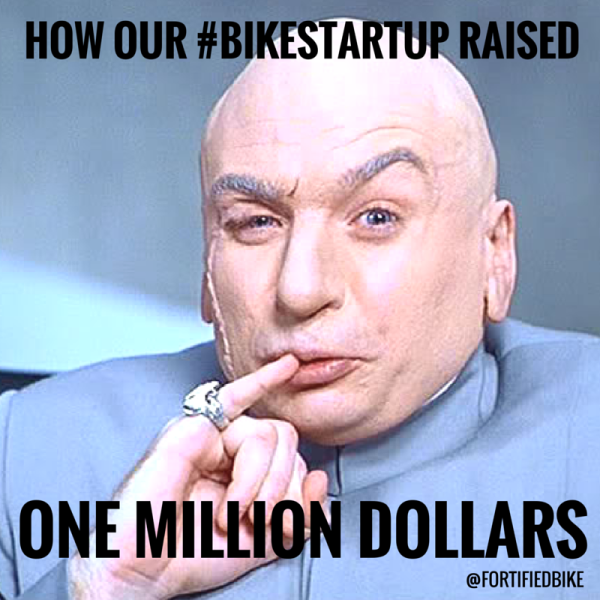#BIKESTARTUP is a scrappy, in-the-trenches guide designed to turn your idea into a full-fledged bike business. We’ve covered customer research, prototyping, manufacturing, and raising money without investors. Now let’s talk real money.
The last six months on the fundraising warpath was one of the most emotionally challenging experiences of my life. If you can start and grow a business at a speed that makes you happy, then don’t raise money. There are many fundraising options, like Kickstarter, that don’t require investors. But if you’re ambitious (read: impatient) and organic growth is not fast enough, then fundraising is the startup steroid you need.
When I say raising money I’m not talking about borrowing $20K from your friend’s rich dad. I’m talking about finding experienced, professional early-stage angel investors and venture capitalists (VCs), who will inject funding into your company and expect a big return. And believe me, this looks nothing like an episode of Shark Tank.
Here’s what we did to raise money…
1. We had to prove traction:
In the 1980s you’d sit at a typewriter and write a 30-page business plan to raise money. A VC would read it, invite you to a series of meetings, and if they liked your plan, write you a fat check. In 2015 business plans are dead. It’s far better to build a minimal viable product than to pontificate for 30 pages. We hacked prototypes, showed them to customers, and launched a Kickstarter. If we hadn’t done that, we would have only raised $0-$50K at a company valuation of $200-$500K. Since we had proved traction with thousands of customers using our theft-resistant bike lights before raising money, we raised $1M at a multi-million dollar valuation.
2. We harnessed our inner Dr. Evil:
A VC who invests in your startup is looking for a 10X return on investment (ROI). When an VC funds 5 companies, they expect 2-3 to die a fast death, 1-2 to give a boring 2X return, and one to be an Uber (aka “unicorn”) that’ll return their entire investment portfolio. That’s why 10X ROI is the magic number. To hit 10X ROI, Fortified Bicycle will have to be #1 in our category: city bicycling.
So, next we needed to convince investors we could become #1 in this category. When we started pitching investors, we made the mistake of pitching chronologically: “First we made these theft-proof bike lights, now we’re launching a theft proof bike, in five years we will TAKE OVER THE WORLD”. By the time TAKE OVER THE WORLD entered the pitch VCs were already eye-glazed and checking their Apple Watches.
So we flipped the script. It sounded like this:
“We’re going to TAKE OVER THE WORLD – with our products, everybody will be biking in cities every day. To get there we’ll start by launching a theft-proof bike on Kickstarter this fall. How do we know we’re going to succeed? Look at the traction of our theft-proof bike lights!
Start with your big, scary, crazy vision of TAKING OVER THE WORLD. That’s what gets investors excited. Then back into your traction (i.e. evidence) that you can pull it off.
3. We didn’t waste time on non-believers:
Ben Berte, a friend, Harvard educator and entrepreneur taught me, “don’t waste your time with non-believers. They’ll never get your vision anyways. Spend your time finding the believers.” Many investors simply won’t get your idea, but you’ll find a few (in our case, 19 out of the 200 we pitched) that understand immediately. Within minutes of pitching them, these investors are tossing ideas back at us. They gave us inspiration and you walk out of that coffee shop ready to TAKE OVER THE WORLD!
And those 181 non-believers that negged us? They were super-valuable as well! Every rejection is an opportunity to experiment and learn. After every meeting, my cofounder Tivan and I would tweak our pitch like standup comedians constantly refining a routine after each show. 100 entrepreneur-hours and several all-nighters later we were at investor pitch #25 and our “routine” was solid gold. Checks started to roll in. At that point we knew a rejection wasn’t our fault: it was because the investor was a non-believer. Instead of trying to convert them to a believer we spent that time finding believers.
These points just scratch the surface and I’ll take a deeper dive into the process in the future. In the meantime, ask me questions in the comments. As always, I’ll answer every single one of them.
Slava Menn is a serial entrepreneur and CEO of Fortified Bicycle. He loves biking, building, entrepreneuring, and teaching. In this monthly series, he shares his team’s hard-learned startup lessons with aspiring entrepreneurs.
